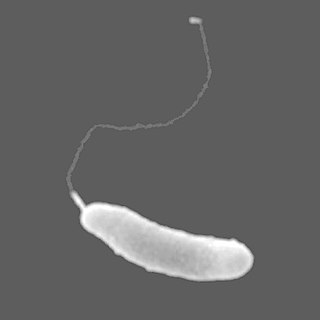Marinomonas alcarazii is a Gram-negative and aerobic bacterium from the genus of Marinomonas which has been isolated from the seagrass Posidonia oceanica.
Marinomonas aquimarina is a bacterium from the genus of Marinomonas which has been isolated from oysters and seawater.

Marinomonas arctica is a Gram-negative, psychrotolerant and motile bacterium from the genus of Marinomonas which has been isolated from sea-ice from the Canadian Basin from the Arctic Ocean.
Marinomonas brasilensis is a Gram-negative and aerobic bacterium from the genus of Marinomonas which has been isolated from the coral Mussismilia hispida from the São Sebastião Channel in Brazil.
Marinomonas fungiae is a Gram-negative, aerobic, rod-shaped and motile bacterium from the genus of Marinomonas which has been isolated from the coral Ctenactis echinata from the Andaman Sea.
Marinomonas hwangdonensis is a Gram-negative, rod-shaped and motile bacterium from the genus of Marinomonas which has been isolated from seawater from the Yellow Sea on Korea.
Marinomonas pontica is a Gram-negative bacterium from the genus of Marinomonas which has been isolated from sea water from the Black Sea in Ukraine.
Marinomonas primoryensis is a Gram-negative, aerobic, psychrophilic, halophilic and motile bacterium from the genus of Marinomonas which has been isolated from coastal sea ice.
Marinomonas profundimaris is a Gram-negative bacterium from the genus of Marinomonas which has been isolated from deep-sea sediments from the Arctic Ocean.
Marinomonas spartinae is a Gram-negative, chemoorganotrophic, aerobic and halophilic bacterium from the genus of Marinomonas which has been isolated from the plant Spartina maritima.
Marinomonas ushuaiensis is a Gram-negative, psychrophilic, rod-shaped, non-spore-forming and motile bacterium from the genus of Marinomonas which has been isolated from coastal sea water from Ushuaia in Argentina.
Marinomonas vaga is a bacterium from the genus of Marinomonas which has been isolated from seawater from Hawaii.

Candidimonas bauzanensis is a Gram-negative, facultatively anaerobic, psychrophilic and motile bacterium from the genus Candidimonas which has been isolated from soil from Bozen in Italy.
Micromonospora mangrovi is a bacterium from the genus Micromonospora which has been isolated from mangrove soil in Beihai in China.
Glaciimonas alpina is a bacterium from the genus of Glaciimonas which has been isolated from cryoconite from the Tiefenbachferner glacier in Austria.

Glaciimonas frigoris is a Gram-negative, psychrophilic, rod-shaped and motile bacteria from the genus of Glaciimonas which has been isolated from the permafrost from Siberia. Glasciimonas frigoris has been shown to grow well in temperatures ranging from -5 °C to 25 °C.

Beigang Island, literally North Port Island, is a small island located in the mouth of Dongzhai Harbor, Hainan, China. There are three villages, fish farms, and some mangroves on the island. Beigang Island is under the jurisdiction of Meilan District.
Agromyces bauzanensis is a Gram-negative and aerobic bacterium from the genus of Agromyces which has been isolated from hydrocarbon-contaminated soil from Bozen in Italy.
Thiophaeococcus mangrovi is a Gram-negative bacterium from the genus of Thiophaeococcus which has been isolated from mud from the Bhitarkanika mangrove forest from Orissa in India.
Zunongwangia mangrovi is a Gram-negative, rod-shaped, strictly aerobic, slightly halophilic and non-motile bacterium from the genus of Zunongwangia which has been isolated from the mangrove Avicennia marina from Tamil Nadu.



